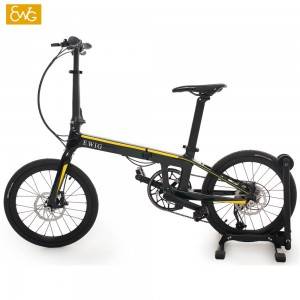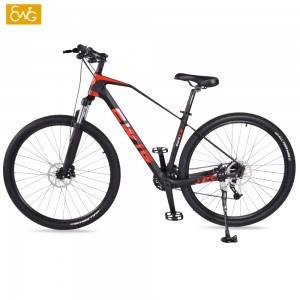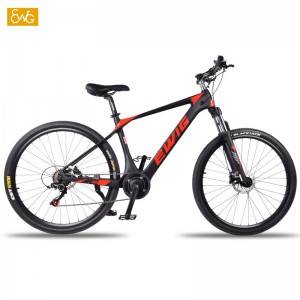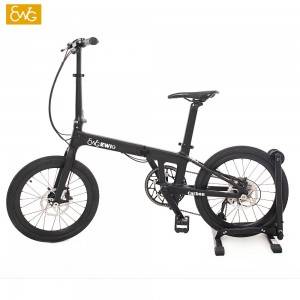China carbon folding bike 9 speed color changeable folding bike factory | Ewig
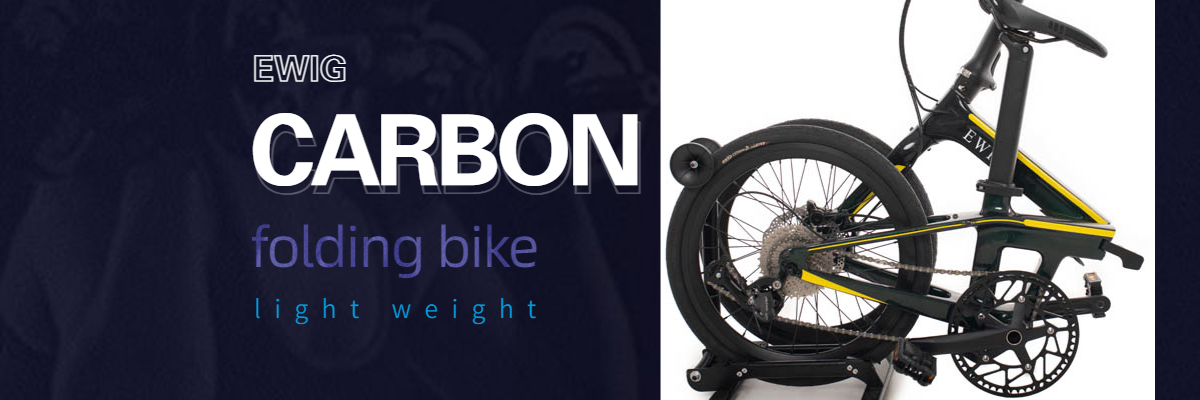
Product Detail:
1.The Ewig folding bike ships ready to ride, fully assembled, a frame with 2 years warranty, weight is 8.1kg without pedals, dis- brake. It is with fashion design. 9 Speed folding city bicycle with Shimano M2000 Shifter, Shimano M370 rear derailleur; TEKTRO HD-M290 HYDRAULIC, with a quality gear system that rides smooth.
2. Bicycle frame and fork are made by Japan Toray T700 Carbon Fiber, Uniquely Strong and light, better corrosion resistance, and toughness. The foldable design makes it more convenient to store without occupying more space. After fold 80 * 64 * 40 cm, easy to carry on trains and buses.
3. The design features a custom mechanism that allows the back wheel to fold under, while still keeping the chain in tension so that it doesn't drop. Ewig folding bike is a lightweight folding bike, The design uses carbon fiber because it is lighter than steel and absorbs shock vibrations better.
4. China 9 speed folding bikes are convenient to store in small spaces, though they can be a bit on the heavy side. Some independent designers are turning to crowdfunding to get their lighter, snazzier folding bike designs off the ground, and the Ewig folding bike factory is no exception, offering an eye-popping, carbon fiber model that weighs a feather-light 8.1KG.
5. Whatever you look for a convenient carbon fiber folding bike for commute, or a carbon mountain bike for adventure, or a road bike for city cycling, even a carbon fiber electric bike. You always can find the suitable one. Besides carbon frame, our bicycle comes with from entry-level to high-end level Shimano groupset.
Full Carbon Folding Bike
| Foldby one 9s | |
| Model | EWIG |
| Size | 20 Inc |
| Color | Green Yellow |
| Weight | 8.1KG |
| Height Range | 150MM-190MM |
| Frame & body carrying system | |
| Frame | Carbon fiber T700 |
| Fork | Carbon fiber T700*100 |
| Stem | No |
| Handlebar | Aluminum black |
| Grip | VELO Rubber |
| Hub | Aluminum 4 bearing 3/8" 100*100*10G*36H |
| Saddle | Full black road bike saddle |
| Seat Post | Aluminum black |
| Derailleur / brake system |
|
| Shift lever | SHIMANO M2000 |
| Front derailleur | No |
| Rear Derailleur | SHIMANO M370 |
| Brakes | TEK TRO HD-M290 Hy draulic |
| Transmission system | |
| Cassette sprackets: | PNK,AR18 |
| Crankset: | Jiankun MPF-FK |
| Chain | KMC X9 1/2*11/128 |
| Pedals | Aluminum foldable F178 |
| Wheelset system | |
| Rim | Alumimum |
| Tires | CTS 23.5 |
Images for Carbon folding bike
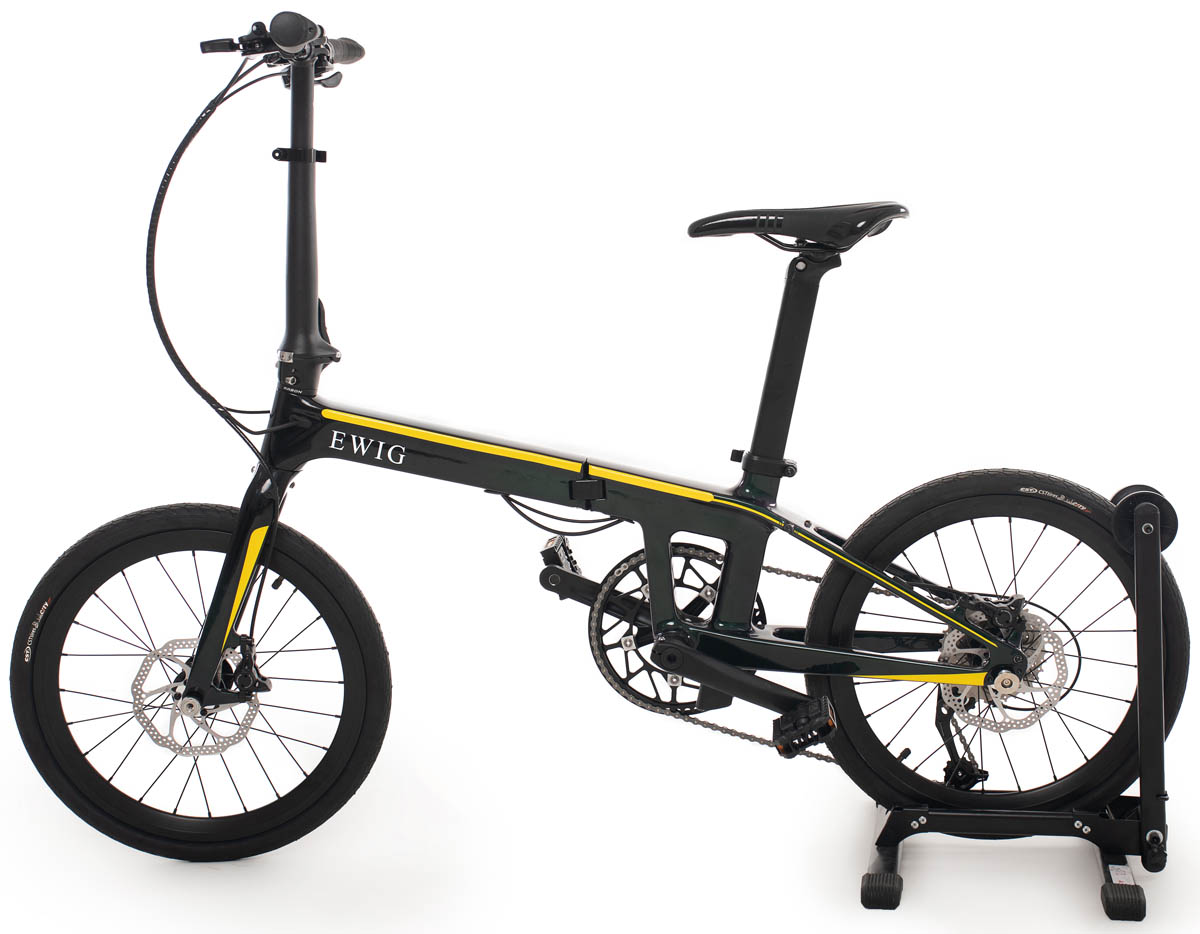
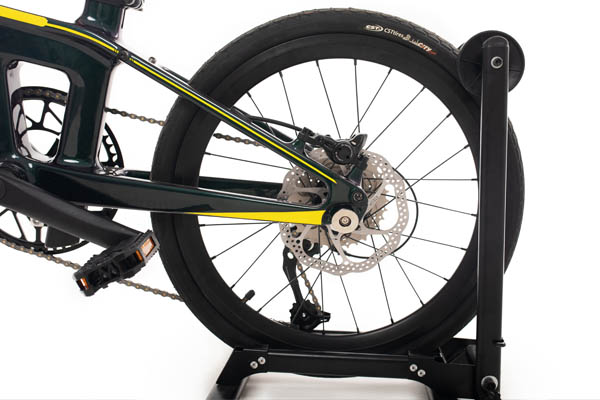
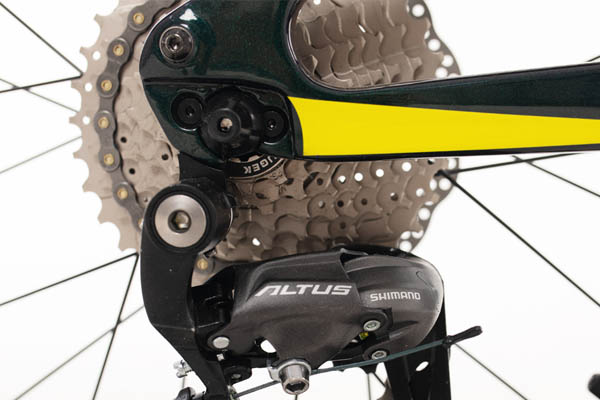
Details
Learn more about EWIG products





what is a carbon bike ?
A carbon fiber mountain bike is made from weaving carbon fibre strands and then setting within a hard epoxy resin, carbon mountain bike frames are very light, strong and reasonably stiff. The material is also easy to craft into aerodynamic shapes, and allows engineers to really play with variable strength or flex in crucial areas around the bike.
For many riders, the weight of the bike is the primary concern. Having a lightweight bike makes climbing easier and can make the bike easier to manoeuvre. Whilst it’s possible to make a light bike out of either material, when it comes to weight, carbon definitely has the advantage. A carbon fibre frame will almost always be lighter than an aluminium equivalent and you’ll only find carbon fibre bikes in the pro peloton,in part because of the weight benefits.
Carbon being one of the most optimizable materials is used in some of the best bikes, Formula One and planes. It’s light, stiff, springy and stealthy. The problem is that not all Carbon is created equal and just the name tag does not guarantee that it’s better than other frame materials such as aluminum.
why carbon fiber bike frame?
The primary advantage of the material is that at a given stiffness, carbon fiber is significantly lighter than aluminum, steel, or titanium. This lower density also means carbon frames do a better job of absorbing (rather than transmitting) road vibration, which translates into a more comfortable ride.
An Insight Into All The Advantages Of Carbon Fibre Bikes
Carbon fibre bike frames were once the preserve of super-expensive elite-end racing bikes, but with improved manufacturing techniques these amazing frames are now starting to become more widely available for the road rider who is chasing speed on a more realistic budget.
The first thing people think of is the weight, and yes carbon fibre in bikes makes the lightest bike frames. The fibrous nature of the material allows frame builders to adjust stiffness and compliance by aligning the carbon layers in varying ways. For example, the carbon fibre bike frame will have stiffness in the bottom bracket and head tube areas for power delivery and control, and compliance in the seat tube and stays for rider comfort.
It makes for a smoother, more comfortable ride
The main benefit for non-competitive riders is the comfort of a carbon bike frame. Where aluminium transfers vibration and shock through the bike, carbon bike fork benefits from vibration damping qualities that give a smoother ride.
It’s stronger and more durable
Technical improvements in the weave and epoxy, and the ability of designers to build in strength in frame areas where it is needed most, mean carbon can now be used to build a very durable bike frame.
how to remove paint from carbon fiber bike frame?
Use the brush to spread the paint remover over the frame. You don’t need to make sure it soaks in or anything, but just layer it on top. Do one coat of this all over the frame. Then leave the paint remover on the bike for 5-10 minutes and paint should begin to peel off a tiny bit.
Do not use any sort of chemical or paint thinner. It will destroy your frame. To remove paint and decals from a carbon frame, you have to hand sand the entire frame.
how to store a carbon fiber bike?
As the number of bikes in the house grows, storage becomes more of a problem. I have some hooks that I hang my touring bike and the gravel bike on (hanging from the front rim), but they both have durable aluminum rims.
I now have to find a way to store a new all-carbon mountain bike, one that has aerodynamic carbon rims, a carbon seat-post, etc. I don’t want to leave it sitting on the floor, lest I forget to keep the tyres pumped up. I don’t want to hang it from a hook, since I’m sure that’s not how the rims are expected to be loaded. I could use a clamp to hold it by the seatpost, but again since that would leave it under a certain amount of torque for months, I’m not comfortable with it.
In most carbon wheels, the carbon is structural, i.e. it’s full carbon construction that has to resist the pull of the spokes. These should be more than able to withstand the weight of the (presumably light) bike. Pad the hooks if not already done so.
I don’t see a real issue with storing the bike upright on the floor unless you have tubular wheels. With my cyclocross tubulars, the recommended best practice was to hang the wheels, lest side forces dislodge the tubular from the rim entirely or just force it off straight. With tubeless wheels, if you let the wheels lose air entirely, you might need to ensure the tire beads are seated properly in the center channel before reinflating. If the tires got dislodged, I suppose it’s possible you could spill sealant.
how much does a carbon fiber bike weight?
When it comes to choosing the perfect bike, one of the most considered factors is its weight. A lot of cyclists believe that the lighter their bike is, the faster it will be. But, is the weight of your bike truly all that makes the difference? And, are the extra bucks you pay for a lighter bike worth it? Although, whether you’re a weight weenie or not largely depends on what you do with your bike. If you cycle purely for fun and as a hobby, weight might not be a big deal to you. But if you’re going to be participating in a race or you’re bike commuting, weight can be of great concern. Besides the speed benefits, lighter bikes are also easy to transport, store and lift in traffic. While the speed of your bike is dependent on several factors, which of course include its weight. Your power-to-weight ratio, strength, and resistance are also key factors that influence your bike’s speed.
The average carbon road bike weighs approximately 8.2kg (18 pounds). Like every other bike category, the frame size, frame material, wheels, gears, and tire size can change the overall weight. Carbon fiber bike frames are strong, reasonably stiff and in fact, the lightest. As the name suggests, they are made from carbon fiber strands and a hard epoxy resin. Although carbon road bikes are quite expensive, they, however, provide you with a smoother and more comfortable ride. Also, they tend to have higher durability and strength compared to other bike categories. Despite their proven efficiency, most riders within budget would rather go for a different category of bike – until recently. Improvements in technology and manufacturing techniques are beginning to make carbon road bikes more affordable and available. If you’re looking for speed and lightweight, and wouldn’t mind what it would cost, an investment in a carbon fiber road bike would be worth it.

